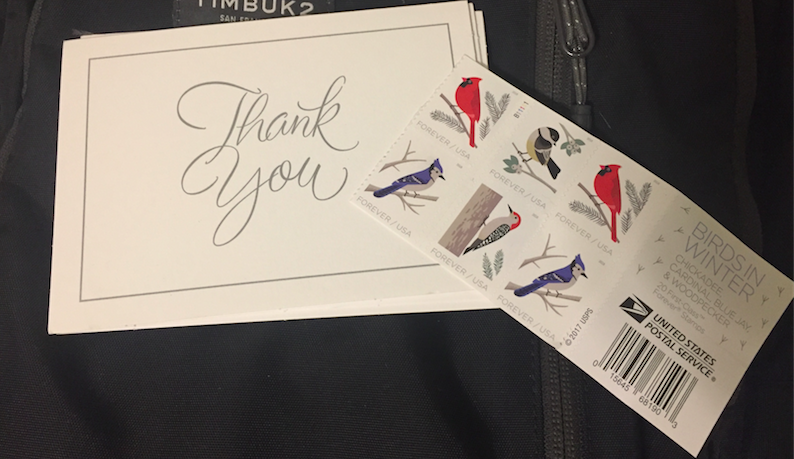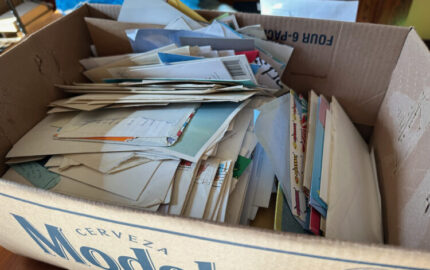I have a strong belief in proper thank-you notes, with research to back me up. I consider it a patriotic duty to buy stamps lest the U.S. Postal Service become another victim of digital convenience. And I am always looking for short, effective assignments to use in writing workshops. So Angel's post was nothing short of a hat trick for me, and especially apt coming on Thanksgiving week.
But when I went back a bit later, it was gone. I sent Angel a note asking about it. She said she had decided to take it down for fear she was bragging on herself. (Did I mention she was from Kansas City, aka the Midwest?) I reframed my question as the request for a favor, and she sent this:
The Thank-you card assignment
I am teaching an Introduction to Human Communication this semester at Park University, a small liberal arts college in a river town outside of Kansas City. Students come from a variety of backgrounds. We have international students, military veterans, student athletes and commuters.
I have attempted to incorporate in-class activities throughout the semester to urge them to engage with others in ways that might be beyond what this social-media generation, with hands and eyes fixated on cell phones, believes is the norm.
It hit me a few weeks ago to purchase stamps and thank-you cards and ask them to write a thank-you note to someone, anyone they choose, during class time. It seemed like a perfect Thanksgiving week activity that combined the art of written communication and the simple human gesture of handwriting a note of gratitude.
Sure, there were a few chuckles and eye rolls when I pulled out the cards. But most students seemed to know right away who they wanted to thank. They put pen to paper. A few texted someone for an address. I passed around the stamps and encouraged them to mail the cards after class.
We discussed the purpose of thank-you cards – to follow job interviews, for someone who has influenced us in a positive way, for adding a very personal imprint and gesture to our appreciation.
I likely won’t see the outcomes of my attempt at this teaching moment. But it makes me happy to imagine a mom or dad or teacher or coach or friend out there opening a card from someone and feeling a bit of love and light. That is something we could all use these days.
We continued our conversation for a bit (in the digital form, for convenience). A favorite writing workshop assignment of mine involves writing postcards, and I wanted to know if Angel offers any guidance to writing the thank-you notes. Does she suggest students frame them as stories, mention specific moments, push past generic adjectives? Her response:
I didn't direct the students very much. I said send a note to someone you appreciate, like a loved one or friend or mentor. This was the first time in trying this. The students have many different majors and this course is a communication credit. There is a public speaking component as well, and though we talk about organizing your writing and speaking (using outline and finding the fine detail, transition and scene setting of narrative) it is different from having a class of writers or journalists. Many are very shy. That is one of the reasons I didn't press them to tell us who they were writing to. I also thought that they were more likely to send the cards and write on a more personal level if they knew they weren't sharing them or if I wasn't reading them.
Angel and I then had a brief but thoughtful exchange about discovering the fuller and more intimate stories of our ancestors when we find their letters, about the ethics of making those discoveries public, and even about the quandary over what to do with our own journals or letters. She came back with this wise challenge:
Well, now you have a few more topics for Storyboard – perhaps exploring the letters that famous storytellers or writers leave to their loved ones? Often someone comes across them and sells them and then they are public in some sort of book form. What is gained, what is lost, in sharing them?
A lot to chew on here. But for now, a few lessons to tease out of that thank-you note assignment that can be applied to any good writing:
- The note puts the writer in mind of a single person, someone they care about and want to reach. When we do stories for broad publication, we too often lose that sense of one-to-one communication. The best stories make each reader or listener or viewer feel they are being spoken to directly.
- Sending the note means the writer has to take responsibility for what is written, and how. But it also gives the writer a receptive audience – who doesn't want to receive a thank-you note? – so he or she can relax into the writing.
- Framing the assignment as a thank-you note builds in a focus. How many of our stories suffer from lack of the same?
- It's short and fast. No staring at a blank screen, fretting about that 500 or 5,000 word assignment. No reason to procrastinate.
- It involves pen and paper, which slows the hand down, which then allows the brain to slow down, breathe, focus. It means you are not just typing, but thinking – about what you want to say and who you want to say it to.
Editor’s note: At Storyboard, we’re always looking for moments of inspiration, epiphany and, yes, struggle that we can all relate to or learn from. We hope to make such discoveries a more regular feature under Short Takes. Send your found gems to editor@niemanstoryboard.org.



